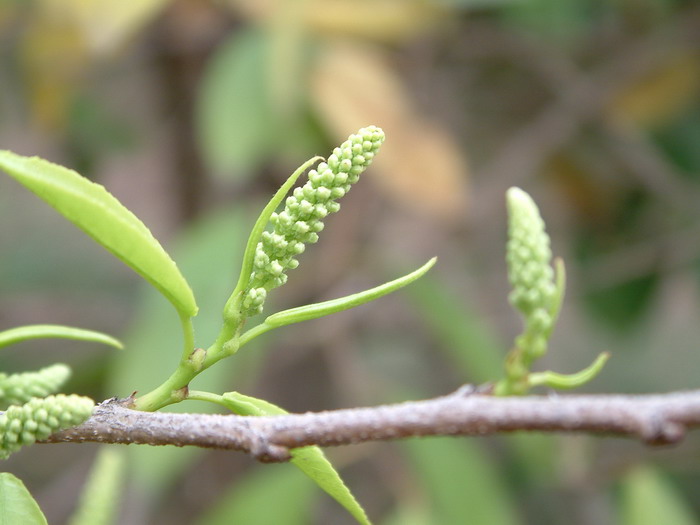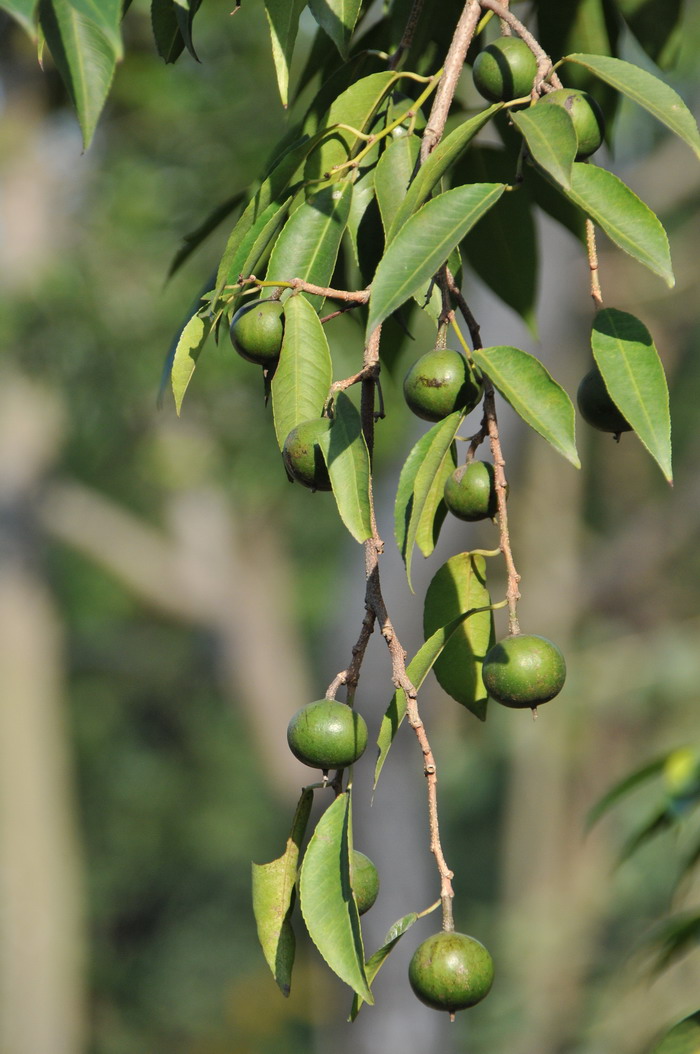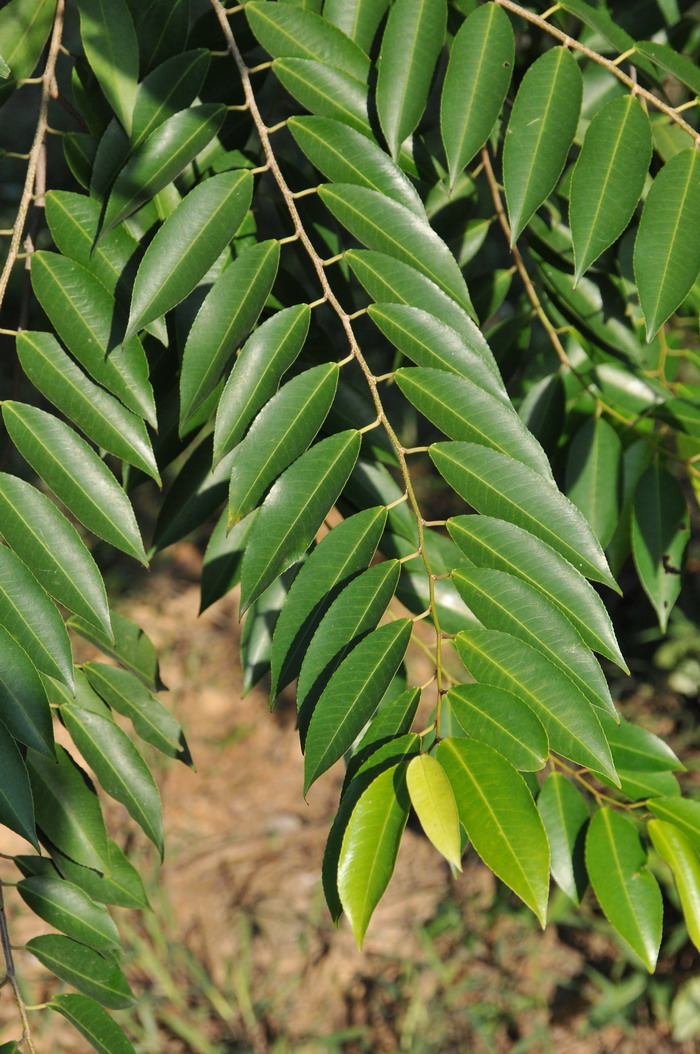齿叶乌桕Shirakiopsis indica
中文名(Chinese Name):齿叶乌桕
学名(Scientific Name):Shirakiopsis indica (Willd.) Esser
英文名(English Common Name):
别名(Chinese Common Name):
异名(Synonym):Shirakia indica (Willd.) Hurus. Stillingia bingyrica Baill. Stillingia diversifolia Miq. Stillingia indica (Willd.) Oken Sapium hurmais Buch.-Ham. Sapium indicum Willd. Sapium bingerium Roxb. ex Willd. Sapium bingyricum Roxb. ex Baill. Sapium diversifolium (Miq.) Pax Excoecaria diversifolia (Miq.) Müll.Arg. Excoecaria indica (Willd.) Müll.Arg.
科属(Family & Genus):大戟科(Euphorbiaceae)齿叶乌桕属
形态特征(Description):
分布(Distribution):
用途(Use):
引自中国植物志英文版FOC Vol. 11 Page 286
Shirakiopsis indica (Willdenow) Esser, Blumea. 44: 185, Map 5. 1999.
齿叶乌桕 chi ye wu jiu | Euphorbiaceae | Shirakiopsis
Sapium indicum Willdenow, Sp. Pl. 4: 572. 1805; Excoecaria indica (Willdenow) Müller Argoviensis; S. bingyricum Roxburgh ex Baillon; Shirakia indica (Willdenow) Hurusawa; Stillingia diversifolia Miquel.
Trees up to 30 m tall, to 40 cm d.b.h., bole twisting, with spines at base. Stipules 1-2 mm; petiole 1-1.5 cm, sparsely pilose to glabrous, eglandular at apex; leaf blade oblong to elliptic or slightly ovate, 7-14 × 3-4 cm, leathery, abaxially with 2-4 glands per side, base obtuse, margins conspicuously serrate, apex subacuminate to acuminate; lateral veins 18-24 pairs, at 60°-66° to midrib. Inflorescence solitary, racemelike, to 10 cm, axis pilose. Male flowers: bracts broad, ciliate, bases with 2 glands; pedicels 1-2 mm; calyx 0.6-0.8 mm, ciliate; stamen filaments 0.5-0.6 mm at anthesis, nearly absent in bud; anthers 0.4-0.5 mm. Female flowers: pedicel ca. 5 mm; calyx 1.25-1.75 mm, pilose; ovary ovate, ca. 2.5 mm; styles ca. 1.5 mm; stigmas 4-6 mm. Fruiting pedicel 8-22 mm; capsules subglobose, 18-30 × 20-32 mm, rounded at both ends or slightly attenuate at base, obscurely 3-lobed, walls of cocci very thick and hard. Seeds often less than 3 per fruit, ellipsoid, 11-13 × 7-8.5 mm, keeled on back, medium to pale brown, not spotted, without caruncle. Fl. Jun-Jul.
Along rivers and seashores, gallery, tidal, and mangrove forests, primary and old secondary forests of swampy and seasonally inundated areas; below 100 m. Guangdong [native to Bangladesh, Brunei, India, Indonesia, Malaysia, Myanmar, Papua New Guinea, Singapore, Sri Lanka, Thailand, Vietnam; Pacific islands (Bismarck Archipelago, Caroline Islands, Solomon Islands)].
Shirakiopsis indica is cultivated for timber and used medicinally. A drying oil is obtained from the seeds, which are edible, though the outer layers of the fruit and other parts of the plant are poisonous and have been used as fish poisons. It is of particular interest because of its ability to grow in waterlogged soils.



(责任编辑:徐晔春)
学名(Scientific Name):Shirakiopsis indica (Willd.) Esser
英文名(English Common Name):
别名(Chinese Common Name):
异名(Synonym):Shirakia indica (Willd.) Hurus. Stillingia bingyrica Baill. Stillingia diversifolia Miq. Stillingia indica (Willd.) Oken Sapium hurmais Buch.-Ham. Sapium indicum Willd. Sapium bingerium Roxb. ex Willd. Sapium bingyricum Roxb. ex Baill. Sapium diversifolium (Miq.) Pax Excoecaria diversifolia (Miq.) Müll.Arg. Excoecaria indica (Willd.) Müll.Arg.
科属(Family & Genus):大戟科(Euphorbiaceae)齿叶乌桕属
形态特征(Description):
分布(Distribution):
用途(Use):
引自中国植物志英文版FOC Vol. 11 Page 286
Shirakiopsis indica (Willdenow) Esser, Blumea. 44: 185, Map 5. 1999.
齿叶乌桕 chi ye wu jiu | Euphorbiaceae | Shirakiopsis
Sapium indicum Willdenow, Sp. Pl. 4: 572. 1805; Excoecaria indica (Willdenow) Müller Argoviensis; S. bingyricum Roxburgh ex Baillon; Shirakia indica (Willdenow) Hurusawa; Stillingia diversifolia Miquel.
Trees up to 30 m tall, to 40 cm d.b.h., bole twisting, with spines at base. Stipules 1-2 mm; petiole 1-1.5 cm, sparsely pilose to glabrous, eglandular at apex; leaf blade oblong to elliptic or slightly ovate, 7-14 × 3-4 cm, leathery, abaxially with 2-4 glands per side, base obtuse, margins conspicuously serrate, apex subacuminate to acuminate; lateral veins 18-24 pairs, at 60°-66° to midrib. Inflorescence solitary, racemelike, to 10 cm, axis pilose. Male flowers: bracts broad, ciliate, bases with 2 glands; pedicels 1-2 mm; calyx 0.6-0.8 mm, ciliate; stamen filaments 0.5-0.6 mm at anthesis, nearly absent in bud; anthers 0.4-0.5 mm. Female flowers: pedicel ca. 5 mm; calyx 1.25-1.75 mm, pilose; ovary ovate, ca. 2.5 mm; styles ca. 1.5 mm; stigmas 4-6 mm. Fruiting pedicel 8-22 mm; capsules subglobose, 18-30 × 20-32 mm, rounded at both ends or slightly attenuate at base, obscurely 3-lobed, walls of cocci very thick and hard. Seeds often less than 3 per fruit, ellipsoid, 11-13 × 7-8.5 mm, keeled on back, medium to pale brown, not spotted, without caruncle. Fl. Jun-Jul.
Along rivers and seashores, gallery, tidal, and mangrove forests, primary and old secondary forests of swampy and seasonally inundated areas; below 100 m. Guangdong [native to Bangladesh, Brunei, India, Indonesia, Malaysia, Myanmar, Papua New Guinea, Singapore, Sri Lanka, Thailand, Vietnam; Pacific islands (Bismarck Archipelago, Caroline Islands, Solomon Islands)].
Shirakiopsis indica is cultivated for timber and used medicinally. A drying oil is obtained from the seeds, which are edible, though the outer layers of the fruit and other parts of the plant are poisonous and have been used as fish poisons. It is of particular interest because of its ability to grow in waterlogged soils.
(责任编辑:徐晔春)
踩一下[0]

顶一下[1]